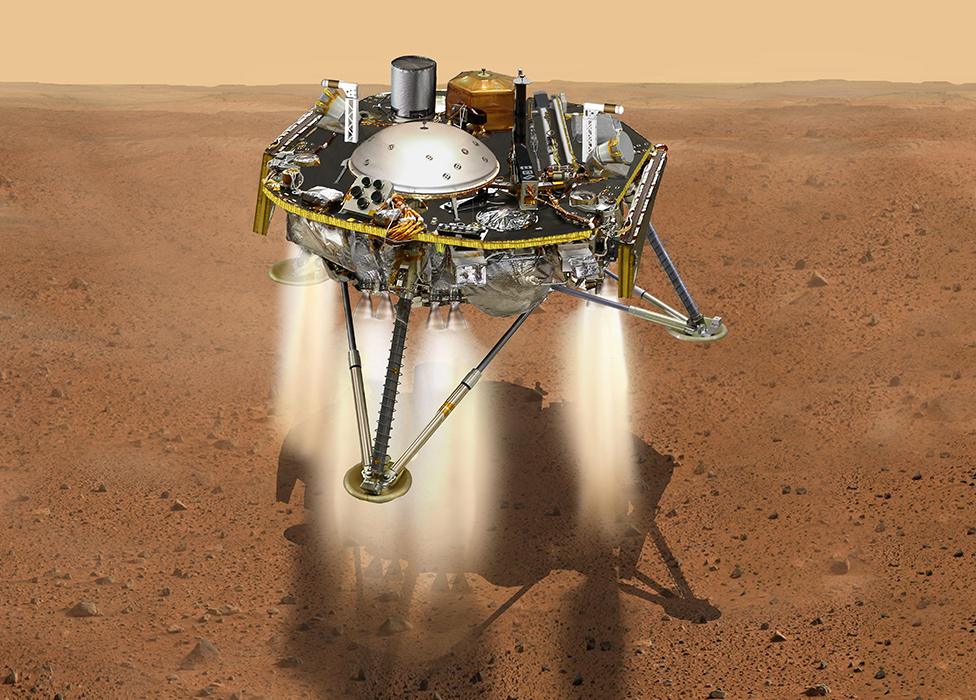European satellite captures Nasa Mars lander from orbit
- Published

The picture of the InSight landing location was acquired on 2 March

Europe's newest satellite at Mars has spied the landing site of the American-led InSight probe.
The Nasa spacecraft touched down in November on flat terrain close to the equator in a region referred to as Elysium Planitia.
The joint European-Russian Trace Gas Orbiter (TGO) then passed overhead in March to capture the scene.
Visible in the TGO CaSSIS camera image are the lander and the elements that got it safely to the ground.
These components include the parachute and the two halves of the capsule that protected InSight during its fiery descent through the atmosphere - its heatshield and backshell.
Something else that can be seen are the scorch marks around the probe that were made by the craft's rocket engines as it gently put down on Mars' surface.

Artwork: Twelve thrusters brought InSight to a stop at the surface



Burroughs crater near Mars' south polar ice cap. The ice and dust layers have formed a mound in the crater over hundreds of millions of years. They record how the climate of Mars has evolved over time

The picture is one of a newly released batch of images from the CaSSIS (Colour and Stereo Surface Imaging System) team on the TGO mission.
The Swiss-based group's instrument acquires stereo imagery of the planet's surface at a best resolution of 4.5m per pixel.
It's onboard principally to provide visual context for the orbiter's other instruments that are trying to track down the locations on Mars where methane and other trace gases could be being released into the atmosphere.
But when CaSSIS is not doing this tandem work, it is employed as a general purpose imager to study the geology of the planet.


This colour-composite image of the floor of Kibuye Crater in Terra Sirenum highlights the rich variety of mineralogical composition found in the region's rocks

A good example is the picture of the floor of Kibuye Crater in the region of Terra Sirenum, says Prof Nic Thomas from the University of Bern.
"These places where you have a lot of colour diversity is indicating a lot of mineral diversity, and in different layers. This means we could be looking at sedimentary layers where deposition from water was a key process. And because CaSSIS has got this colour and stereo capability, people are really looking to use the camera on these sites," he told BBC News.
The stereo allows scientists to build elevation models and work out how thick layers area.

The crater just to the left of this image is called Jezero. It's where Nasa will send a rover in 2020. This is a red-blue stereo image that is best viewed with "3D" glasses

The Trace Gas Orbiter has been in its science orbit around Mars for almost a year now.
One of its roles is to provide a communications relay for surface operations.
The US space agency's Insight probe and its Curiosity rover will talk to Earth through the TGO.
And when the joint European-Russian Rosalind Franklin rover arrives in 2021, it too will use the orbiter to transfer its data home.


This image covers a portion of the wall-terrace region of the 100km-wide Columbus Crater. The white markings are salts that were deposited when lake water in the crater started to dry out, like a "bath ring"



This mysterious pattern was pictured on the crest of a ridge in the Terra Sabaea region of Mars. The lines are thought to be the tracks left by hundreds or maybe even thousands of "dust devils", mini Martian tornadoes. The false blue colour is used for contrast

Jonathan.Amos-INTERNET@bbc.co.uk, external and follow me on Twitter: @BBCAmos, external